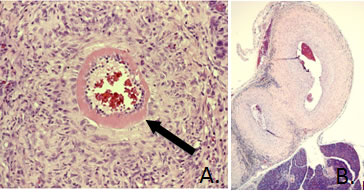Etiology: This condition is associated with hypertension in hypertensive (SHR) strains, renal disease (with hypertension) and aging in male SD rats, especially.
Incidence: The incidence of disease is moderate. Stock and strain impact which arteries are affected. Commonly affected arteries include mesenteric, pancreatic, splenic and testicular arteries.
Clinical Signs: There are usually no clinical signs associated with this condition.
Pathology: Grossly, affected arteries are firm, segmentally thickened and are often described as nodular or tortuous.
Histologically, changes include fibrinoid necrosis (arrow, A.) of the tunica intima and thickening of the tunica media and adventitia. Often, arterial lumens may become obstructed by hypertrophic muscle (B.).
Diagnosis: Diagnosis is made based on histopathologic findings.
